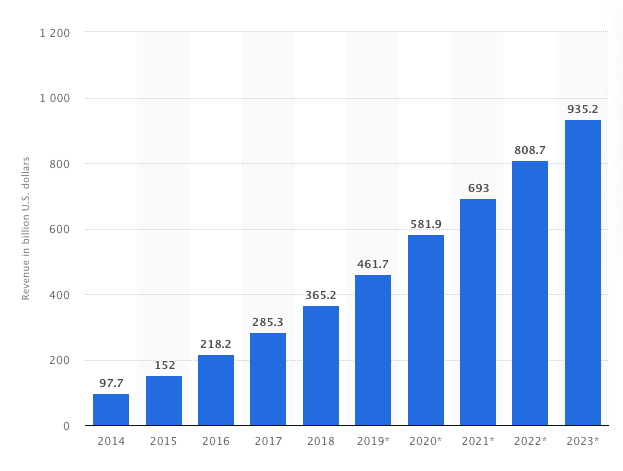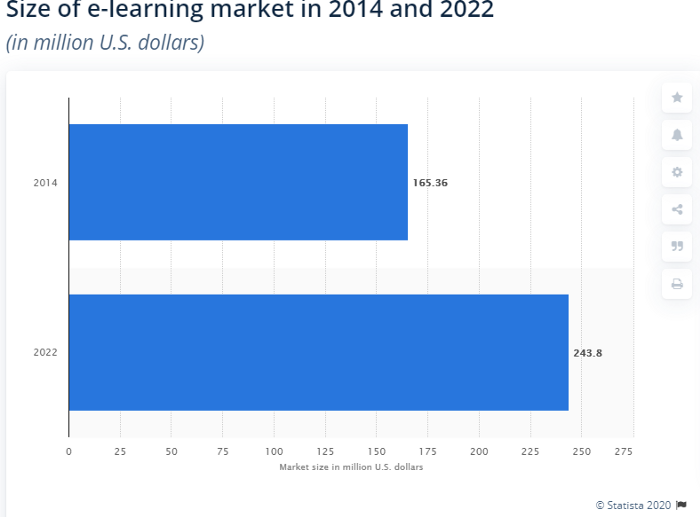It’s been a year that the world is coping with the pandemic that has wreaked havoc on our lives. Quarantine, self-isolation, social distancing, and work from home are the new normal today. There’s practically no social life anymore – people choose to stay within their homes to avoid contracting the deadly virus. Coupled with the regular lockdowns, this has caused the world economy to hit rock bottom.
However, it is interesting to note that while the pandemic gave a severe blow to many industries, it created a huge potential for on-demand apps. With our lives turned upside down and businesses closing left and right, mobile apps have been our constant companions. As the pandemic forced companies to go digital, the mobile and on-demand app market rose steadily.
Statista estimates that by 2023, mobile apps will generate a revenue of over US$ 935 billion through in-app advertising and paid downloads. It further maintains that by 2024, the app revenue is expected to grow at a CAGR of 10.4%, creating a market volume of US$ 5,274million!

What are the on-demand applications?
In layman’s terms, on-demand apps are mobile solutions that allow you to access and enjoy a service in real-time at your choice of physical location. On-demand app services include food & grocery delivery, entertainment, laundry, healthcare, education, etc. Uber, Ola, Urban Clap, and Zomato are some of the most popular on-demand apps.
The idea behind on-demand mobile app development is to deliver a service to users as and when they need it. Since on-demand apps are designed with a particular service in mind, they include an extensive range of helpful features like tracking, wish list, digital payment portal, multiple bookings, reviews & testimonials, etc. Thus, on-demand apps promise speed and convenience to users.
The on-demand app market includes three key elements – service providers, IT firms, and consumers. The role of IT is pivotal here. While the service provider designs a product to target a specific customer need, the IT companies act as intermediaries between the service provider and the customer. They understand the user requirements and service provider’s objectives to develop the ideal app to attract the target crowd. The goal is to leverage best-in-class technologies to create an on-demand app where users can easily access service and even pay for it in real-time.
Impact of on-demand solutions on different industries
Like we mentioned before, the COVID-19 pandemic impacted businesses across different sectors differently. While businesses requiring face-to-face interaction seem to be falling apart, companies that can offer their services online are a hit with customers. For instance, retail, travel and tourism, real estate, fashion, and sports are some industries that lie on the adverse end of the pandemic, it opened up new opportunities for education, healthcare, food, and eCommerce sectors.
Here are the five industries capitalizing on the on-demand solutions market :
1. Grocery & food delivery – Grocery and food items are essentials in our daily lives. In 2020, numerous restaurants and retail grocery outlets shifted their businesses online, resulting in an estimated growth from US$ 36.2 billion (2019) to US$ 117 billion in 2023. Grocery apps Instacart, Walmart Grocery, and Shipt observed a 218%, 160%, and a 124% increase in daily downloads respectively.
2. Healthcare – Since the pandemic is forcing people to stay indoors, they rely on healthcare apps for essential medical services and consultations. Healthcare apps like Medi24 and Push Doctor saw a massive boost in calls and consultations. Another e-telehealth app, Well, reported a 400% hike in the number of downloads.
3. Education – With educational institutions being closed since the beginning of 2020, online learning is the new industry trend. Apps like Byju’s, Khan Academy, Udemy, ClassDojo are a few of the top trending educational platforms. According to Statista, the global e-learning market (for on-demand education) is projected to exceed US$ 243 billion by 2022, growing at a CAGR of 5.08%.
4. Online content and social media – As people spend more time indoors, online content streaming and social media apps have been their constant source of entertainment. YouTube, Facebook, Instagram, TikTok, Netflix, and Amazon Prime emerged as the most popular media channels for people worldwide. As per the latest stats, video apps, on-demand streaming, and live-television report a 22% rise in viewership.
5. Remote work apps – Remote work culture was not acknowledged in the pre-pandemic era. However, now it is the new workplace norm. Professionals are connecting via remote work apps like Zoom, Skype, Google Meet, Microsoft teams, Evernote, Slack, Zapier, and Pocket.
Why are on-demand applications on the rise?
On-demand apps have made our lives much more manageable and comfortable. Thanks to on-demand apps, we can enjoy a wide range of services right from the comfort and safety of our homes.
Here are X benefits (reasons why they're trending now) that on-demand apps offer:
- Varied choices – On-demand apps incorporate multiple features to deliver a top-notch user experience. From seamless navigation to fast payments, on-demand apps promise convenience and real-time delivery. Many on-demand apps include a wide selection of services within one unit, allowing you to choose from multiple options.
- Contactless delivery – Considering that we must limit contact with outsiders as much as possible to break the transmission chain, contactless deliveries are a huge help. You can order anything you want and get them delivered to your doorstep without contacting the delivery person.
- Customer satisfaction – Multiple choices, contactless and one-day/real-time deliveries, and fast payments inevitably increase customer satisfaction quotient. Users can get what they want while being safe.
- Business-savvy – On-demand apps allow businesses to shift to the digital model to keep their businesses up and running during these uncertain times. Ever since the pandemic hit, many enterprises are trying hard to stay afloat. However, by shifting to the online business model via on-demand apps, enterprises can continue operating and generating revenue.
Conclusion
In the wake of the pandemic, times have changed drastically. The world around us is no longer the same. It is crucial to adapt to changing times to survive and thrive. Just as we’ve made numerous changes in our daily routines, businesses must also embrace new technologies and trends to move forward. While it is uncertain how long the pandemic will last, one thing is for sure – on-demand apps are here to stay with the help of mobile app development sevices. Companies and organizations that have already adopted the on-demand model are reaping the benefits.
If there’s one thing that business owners learned during the pandemic, it is the fact that mobile apps are no longer optional – they are an integral part of the modern business model.





